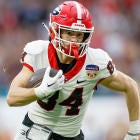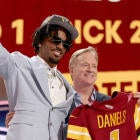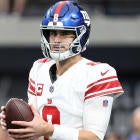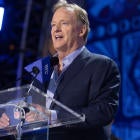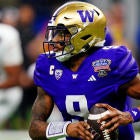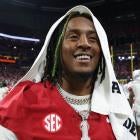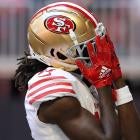Let's travel back in time to 2010.
The Dallas Cowboys are coming off an 11-5 season in 2009 under coach Wade Phillips. They have one of the best offenses in the league, led by Tony Romo -- who at this time looks like one of the top quarterbacks in football and who just won the Cowboys their first playoff game in more than a decade. Romo has a record of 38-17 in his three-plus seasons since taking over for Drew Bledsoe as the starter; he also has the fourth-best passer rating of all time.
The offseason treated the Cowboys well, as they responded to the departure of Romo's No. 3 receiver (Patrick Crayton) by trading up three spots late in the first round to land Oklahoma State star Dez Bryant. Bryant -- widely considered the best college wide receiver -- slipped in the draft because of the dreaded "character concerns," a label he was slapped with after he failed to fully disclose to the NCAA the nature of his relationship with Deion Sanders. (Bryant denied having been to Sanders' house and working out there, when in fact he had.) The Cowboys also fortified their defense by drafting Penn State star linebacker Sean Lee, who fell to the second round after suffering major injuries to both knees.
Peyton Manning's Indianapolis Colts are considered the preseason favorite to win Super Bowl XLV but the Cowboys are in a group of teams right behind them -- they're tied with the New Orleans Saints and San Diego Chargers for the second-best odds in Las Vegas sports books.
The Cowboys don't know it yet, but their season is about to be undermined by their offensive line.
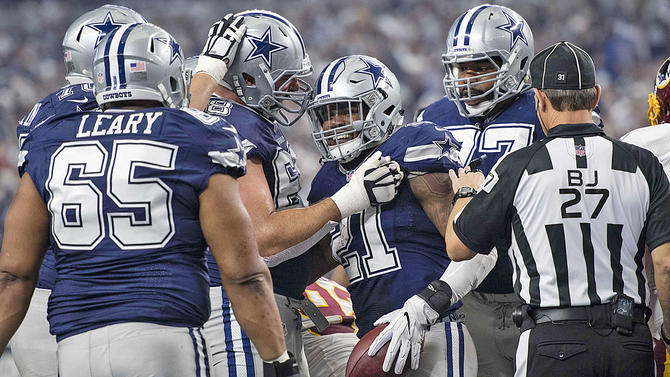
It's Week 1 and the Cowboys are trailing division rival Washington 13-7 with three seconds left. Romo has just led the Cowboys 68 yards to the Washington 13-yard line and everyone in the stadium knows he's about to throw his 48th pass.
Dallas breaks the huddle and lines up Bryant to Romo's right, with Jason Witten, Roy Williams and Miles Austin to Romo's left. Romo takes a shotgun snap from Andre Gurode and his protection almost immediately breaks down. He avoids two rushers by stepping up into the pocket, then escapes to the outside in classic Romo fashion. As he moves to his right, it's clear Williams has broken wide open. Romo flips him the ball in the front of the end zone for a touchdown with no time on the clock. Game over. Cowboys win if they can manage to not screw up the extra point.
Or they would have, if there weren't yellow laundry on the field. Fill-in right tackle Alex Barron grabbed a hold of Vonnie Holliday's jersey on his way around the edge, negating the touchdown and flipping the game's result. The Cowboys fall to 0-1.
This would not be the worst thing the Dallas offensive line would do during the 2010 season.
Fast forward a few weeks. The Cowboys are a disappointing 1-4 and squaring off with another division rival, the New York Giants. It's early in the second quarter and the Cowboys have just recovered a fumble inside Giants territory. Romo drops back to pass, plants his foot and fires under heavy pressure to Austin. Pass complete for 14 yards. First down.
But Romo's not getting up.
The offensive line parted like the red sea and let linebacker Michael Boley come through unblocked on a blitz. Fullback Chris Gronkowski (to answer your question: yes) didn't see Boley coming and released into the flat. Boley leveled Romo with a huge hit and drove him into the ground, with Romo's shoulder taking the weight of his and Boley's entire bodies. It's not long before the Cowboys find out that Romo has suffered a fractured clavicle, effectively putting the final nail in their season's coffin.
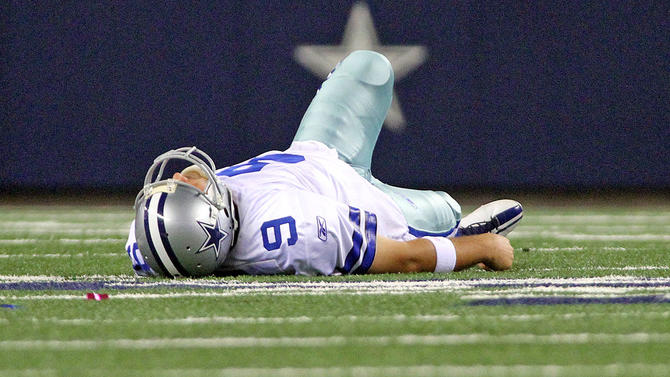
Two weeks later, Jerry Jones will make an in-season coaching change for the first time, elevating offensive coordinator Jason Garrett to replace Phillips. It would take several years, some near-misses and multiple draft picks, but that disastrous early stretch of the 2010 season was the impetus for the decision-making process that led to the Cowboys building the best offensive line in football, one that looks like it has a chance to dominate the league for years to come.
The most notable thing about the 2010 Cowboys' offensive line was its age.
Left tackle Doug Free, in his first full season as a starter after being selected in the fourth round of the 2007 draft, was the line's youngest member at 26 years old. Fellow starters Marc Colombo, Leonard Davis, Kyle Kosier and Andre Gurode were all in their age-32 season. They all had a history of above-average play but they were also all on the downside of their careers. None of them would last more than three additional years in the league.
Combined, that group of five -- along with injury fill-ins Montrae Holland (30), Phil Costa (23) and the aforementioned Barron (28) -- gave the Dallas offensive line a snap-weighted age of 30.5 years old, one of the oldest in football.
Six years later, Free is now the same age his fellow starters were back in 2010. In his age-32 season, he's the senior man and right tackle on the best line in the NFL -- and also the only member of the group older than 27. The nine players that took the field for the Cowboys' offensive line in 2016 had a snap-weighted age of 26.6 years old, reflecting a group of players collectively in or on the precipice of their physical prime.
It's difficult to say who the best player on the Dallas offensive line is, but the foundation of it was built on the massive, sturdy shoulders of All-Pro left tackle Tyron Smith.
All the way back to high school, Smith was considered one of the best tackle prospects in the country, if not the best. He was viewed as a five-star recruit by both Rivals.com and Scout.com and was named an All-American by every scouting service imaginable. It wasn't a surprise when the Los Angeles native landed at Southern California.
After apprenticing as a left tackle under future second-rounder Charles Brown as a freshman, Smith took over as USC's starting right tackle for his sophomore and junior seasons. He quickly emerged as one of the best linemen in the then-Pac-10, eventually winning the Morris Trophy as the conference's top offensive lineman, as voted on by the conference's defensive linemen. After winning the award, he declared early for the 2011 NFL Draft.
Standing 6-feet-5 and weighing just over 300 pounds, Smith was viewed as the prototypical NFL tackle prospect. He had massive 36 3/8-inch arms and 11-inch hands, and he bench-pressed 225 pounds 29 times at his pro day. He tested off the charts both at his pro day and the NFL combine and was considered the most athletic tackle in the draft.
There was a degree of mild concern that Smith was both young (20 years old) and light (307 pounds) for a tackle, but the Cowboys nevertheless made him the No. 9 overall pick. It marked the first time in Jerry Jones' 22 years as the owner of the team that the Cowboys had drafted an offensive lineman in the first round.
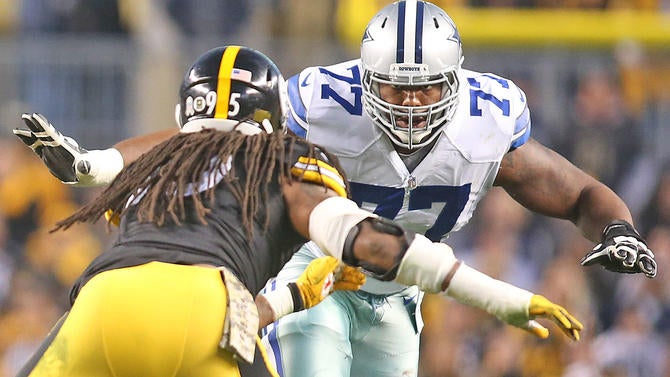
To say the selection has worked out exactly as Dallas planned would be an understatement. Smith spent his rookie year on the right side before flip-flopping with Free before his second season. He has protected the blind sides of Romo and Dak Prescott ever since. He missed just one game in his career before 2016, and starting with his third year in the league has been deservedly named both to the Pro Bowl and Associated Press All-Pro teams each season. He has as good a claim as anybody to the title of "Best Tackle in Football."
Now 320 pounds and still the same incredible athlete he was when he entered the league, Smith is an excellent run-blocker, equally capable of mowing down defensive linemen and scraping by them to make blocks at the second level and all the way downfield. If he gets his body squared and both of his hands on a defender, Smith can do things that barely seem real.
Tyron Smith!!! #CowboysNation
— ✭ Chase ✭ (@ChaseLabNFL) December 12, 2016
Video from: @uSTADIUMpic.twitter.com/8hhim8tHz7
Where Smith really shines, though, is in pass protection. His massive arms and uncommonly strong hands give him an advantage against nearly any pass-rusher that tries to beat him with a power move. Announcers, coaches and players league-wide regularly acknowledge that once Smith hits a rusher with his initial punch, that player has nearly no chance to reach the Dallas quarterback, so strong is the impact of Smith hitting you. Those physical gifts, combined with his remarkably quick kick-step off the snap, result in his rarely getting beat with a speed rush, either. Even when defenders do beat him at the start of a play, he's quick and strong and long enough to recover before they ever get to the quarterback. On the rare occasions where defenders do get the better of him, it's so notable that TV broadcasts often go right to the replay to show how it happened.
Smith is signed to one of the most team-friendly contracts in the league, as he'll make an average of just $12.7 million a year from now through 2023, when he'll incredibly still be just 32 years old.
The least-heralded member of the Cowboys' offensive line is probably left guard Ronald Leary.
Leary played his college ball at Memphis, excelling at both left and right tackle before bumping inside to guard during his senior season, when the rest of the line was beset by injuries. Despite suffering a torn meniscus before that senior campaign, Leary didn't miss any games; he was named to the All-Conference USA second team and shared team MVP honors with Dontari Poe, now a star defensive tackle for the Chiefs.
Before the 2012 draft, it was discovered that Leary's knee issues were more serious than he let on. Leary had osteochondritis dissecans, a degenerative condition that was expected to shorten whatever NFL career he might have had. As a result, he went undrafted despite being considered a mid-round talent on the field. The Cowboys signed him as an undrafted free agent, handing him a $9,000 signing bonus and guaranteeing more than half of his initial salary to secure his services.
Still, Leary did not make the team out of camp and he was instead signed to the practice squad. He didn't make his debut with the active roster until late in the 2012 season, and even then he didn't get on the field. Nate Livings was entrenched as the starter at the time, and he was a pretty good one, too. Livings played much of the 2012 season while injured, though, and he was injured through much of the offseason before the 2013 campaign as well. Leary stepped up into Livings' starting left guard spot and ran away with the job. He started 31 of 32 games there over the ensuing two seasons, including the 2014 campaign that solidified the Cowboys as the best line in the league.
In the 2015 offseason, knowing Leary was soon approaching free agency and knowing that his career is still likely to be a short one, Jerry Jones made signing undrafted offensive lineman La'el Collins a priority. Collins was considered a sure-fire first-round pick (and possible top-10 selection) until shortly before the draft, when his ex-girlfriend was killed and he was suddenly wanted for questioning. Collins was never considered a suspect in the killing and the child his ex-girlfriend was pregnant with at the time of her death was not Collins', but NFL teams were nonetheless scared off. Police in Louisiana didn't actually talk to Collins until after the draft, so many teams were simply afraid of the lack of information about the case.
Once it became clear that Collins did nothing wrong, several teams readied to pounce on him as an undrafted free agent. Jones, of course, made the flashiest argument. He approached Collins along with Romo and the rest of the Cowboys' line and told Collins to come play for the Cowboys so they could form the best offensive line in NFL history. Collins signed later that day.
Leary began the 2015 season as the starter, but after Bryant and Romo suffered early-season injuries, the Cowboys pushed Collins into the lineup for good starting in Week 7. He mashed and mauled in the run game while experiencing some growing pains as a pass-protector, but nevertheless entered the 2016 offseason as the unquestioned starter at left guard. Leary -- knowing he was about to enter into the final year of his contract and was unlikely to see consistent playing time -- pushed for a trade.
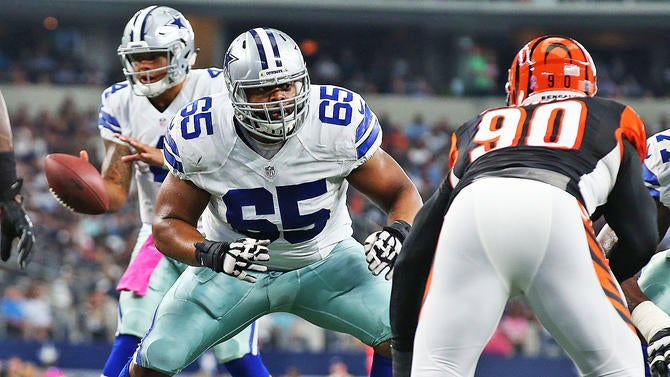
The Cowboys reportedly discussed it with several teams, but ultimately decided to hang onto Leary for one more year. And one would imagine they're quite glad they did. Collins suffered a torn ligament in his toe during Dallas' Week 3 win over the Bears and Leary has been in the lineup ever since. Just as he has throughout his career, Leary played at a very high level in 2016. He's likely in line for a pretty nice contract this offseason, from the Cowboys or somebody else.
The most controversial addition to the Cowboys' offensive line was Travis Frederick, though the only controversy around Frederick these days relates to whether he's the single best center in football or merely one of the top few.
Frederick starred at Wisconsin, where he became the first true freshman in Badgers history to start the team's season opener on the offensive line. He bounced back and forth from center to left guard during the first few seasons of his college career before eventually taking over at center for good when Peter Konz graduated and entered the NFL. As a redshirt junior in 2012, Frederick started all 13 games and was named a first-team All-American.
Frederick was considered a Day 2 draft prospect at best, though, so when the Cowboys traded down from No. 18 and selected him at with the 31st pick in 2013, the pick was widely mocked. Not only had the Cowboys received far too little compensation for moving down 13 picks in the first round (Washington got more to move back from pick No. 22 to No. 30 than the Cowboys did to move from No. 18 to No. 31) but they also made the biggest reach of the draft. Or so people thought.
The big man with the big beard was a star from Day 1 in the NFL. He was the first rookie in Cowboys history to start every game at center, and he immediately was one of the best run-blockers not just at the center position, but in all of football. Inserting him into the middle of the Dallas line solidified everything else around him, and suddenly Dallas was getting the kind of push up front it hadn't gotten in years.
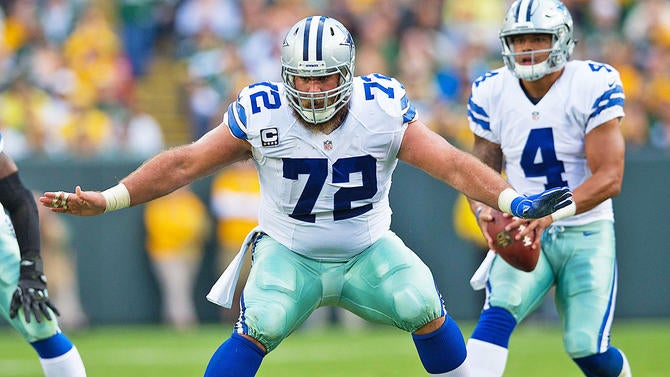
In the three seasons since, Frederick has only gotten better -- in all areas of the game. He has played all 16 games in each of his four seasons, his presence in the middle of the line a calming constant. Frederick's pass-blocking has improved to the point where it nearly matches his continued excellence in the running game. He makes all the calls for the offensive line, working first with Romo and now with Prescott to identify the opponent's front and shift the Cowboys' protection schemes and assignments. He was recently named to his third straight Pro Bowl and his third straight All-Pro team (he finally made the first team after being a second-teamer in 2014 and 2015) and neither of those streaks figures to come to an end anytime soon. Nobody is complaining anymore that the Cowboys reached to take him at No. 31.
Frederick, like Smith, has signed on to stay with the Cowboys for a long time. His contract runs through 2023 and will pay him an average of over $9 million per year. He's the highest-paid center in the league; he's also worth every penny.
Right guard Zack Martin was very close to not being a member of the Cowboys.
After another disappointing 8-8 season, the Cowboys held the No. 16 pick in the 2014 draft. Their plan going in was to select Ohio State linebacker Ryan Shazier, widely considered one of the best defensive prospects in the draft. The Cowboys' defense had been their weakness for years. Pairing Shazier with Lee would finally give them some play-making strength at the second level. When the Pittsburgh Steelers came on the clock at No. 15, though, they snatched Shazier away.
That's when -- if you believe all the rumors and innuendo -- Stephen Jones, Will McClay and Jason Garrett saved Jerry Jones from making a huge mistake. That trio reportedly talked Jerry out of selecting Heisman Trophy-winning quarterback Johnny Manziel and into taking Martin, the second-team All-American tackle out of Notre Dame (there are plenty of people that insist the Manziel talk was more smoke than fire). Martin played left tackle for all four of his seasons with the Irish, setting a school record with 52 offensive line starts. The 2013 Irish allowed just eight sacks with Martin anchoring the blind side, tied for second-fewest in the FBS. Martin was also named the MVP of the Pinstripe Bowl, becoming the first offensive lineman since 1959 to be named MVP of any bowl game.
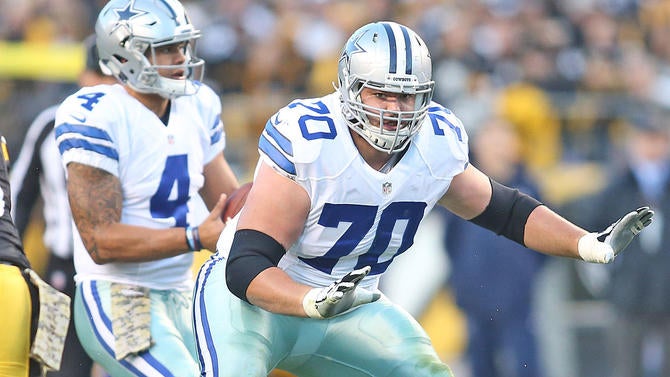
The Cowboys moved Martin from the left side to the right and bumped him inside to guard, where he replaced solid starter Mackenzy Bernadeau. Martin was an immediate upgrade. Like Frederick, he was a star-level contributor from Day 1, only his rookie performance was even better than the star center's. In 2014, while helping the Cowboys' O-Line coalesce into the best unit in football, he became the franchise's first rookie to be named an All-Pro since running back Calvin Hill in 1969. He was the first rookie offensive lineman on any team to be named an All-Pro since 1947.
He has not shown any signs of slowing down since that rookie campaign. Martin has now been in the NFL for three years, and he has been named to the Pro Bowl three times and one of the Associated Press' All-Pro teams three times. He has never finished lower than third in Pro Football Focus' position grading for guards. If he's not the best guard in the league, it's only because Marshal Yanda still exists.
Like Smith and Frederick before him, Martin seems like a good bet to receive a long-term deal that makes him one of the most well-compensated players at his position -- perhaps as soon as this offseason. That deal, too, figures to be well worth it.
It took six years, three first-round picks, two undrafted free-agent signings and several injuries for the Cowboys to slowly but surely build themselves not just the best offensive line, but arguably the single best position group in the NFL. Jerry Jones and Stephen Jones and Will McClay and Jason Garrett made a decision at a certain point to value the offensive front more highly than the team had in the history of Jones' ownership and that decision has paid off in spades.
It paid off for DeMarco Murray. It paid off for Darren McFadden. And it really, really paid off for Ezekiel Elliott and Dak Prescott -- two rookies that have thrived like no pair of rookies ever has before, thanks in large part to the men up front clearing the way for them to put their considerable skill sets to use.
.@DAK. DEZ.
— NFL (@NFL) November 13, 2016
50-yard @DallasCowboys TD!!! #DALvsPIThttps://t.co/R9lDN23lDU
ZEKE with the go-ahead TD!!!
— NFL (@NFL) November 14, 2016
Only 9 seconds remain.
Wowowowowowowow. #DALvsPIThttps://t.co/69sn9wdn3H
The Cowboys have by no means accomplished everything they've set out for just yet. They have bigger goals in sight, both this season and beyond. But they're also arguably as well set up for immediate and future contention as any team in the NFL, and their decision to build their team around a position group that many agree is the most important in football -- and yet is still often ignored or undervalued despite that fact -- is the biggest reason why.














